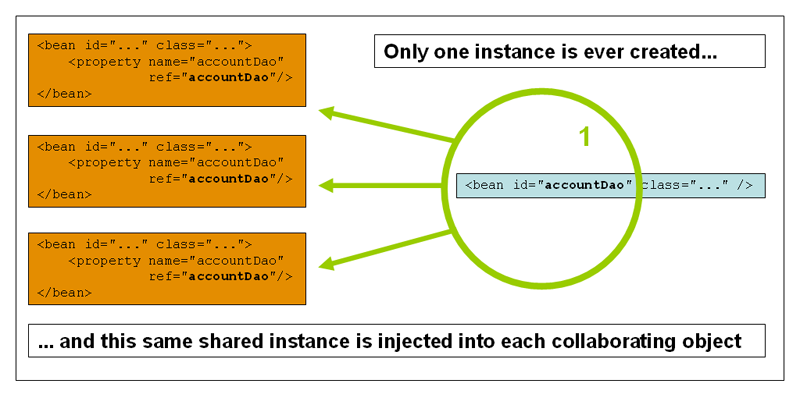3.4. bean的作用域 - Spring Framework reference 2.0.5 参考手册中文版
在创建一个bean定义(通常为XML配置文件)时,你可以简单的将其理解为:用以创建由该bean定义所决定的实际对象实例的一张“处方(recipe)”或者模板。就如class一样,根据一张“处方”你可以创建多个对象实例。
你不仅可以控制注入到对象(bean定义)中的各种依赖和配置值,还可以控制该对象的作用域。这样你可以灵活选择所建对象的作用域,而不必在Java Class级定义作用域。Spring Framework支持五种作用域(其中有三种只能用在基于web的Spring ApplicationContext)。
内置支持的作用域分列如下:
表 3.4. Bean作用域
| 作用域 | 描述 |
|---|---|
|
在每个Spring IoC容器中一个bean定义对应一个对象实例。 |
|
|
一个bean定义对应多个对象实例。 |
|
|
在一次HTTP请求中,一个bean定义对应一个实例;即每次HTTP请求将会有各自的bean实例,它们依据某个bean定义创建而成。该作用域仅在基于web的Spring |
|
|
在一个HTTP |
|
|
在一个全局的HTTP |
当一个bean的作用域为singleton, 那么Spring IoC容器中只会存在一个共享的bean实例,并且所有对bean的请求,只要id与该bean定义相匹配,则只会返回bean的同一实例。
换言之,当把一个bean定义设置为singlton作用域时,Spring IoC容器只会创建该bean定义的唯一实例。这个单一实例会被存储到单例缓存(singleton cache)中,并且所有针对该bean的后续请求和引用都将返回被缓存的对象实例。
下图演示了Spring的singleton作用域。

请注意Spring的singleton bean概念与“四人帮”(GoF)模式一书中定义的Singleton模式是完全不同的。经典的GoF Singleton模式中所谓的对象范围是指在每一个ClassLoader中指定class创建的实例有且仅有一个。把Spring的singleton作用域描述成一个container对应一个bean实例最为贴切。亦即,假如在单个Spring容器内定义了某个指定class的bean,那么Spring容器将会创建一个且仅有一个由该bean定义指定的类实例。
Singleton作用域是Spring中的缺省作用域。要在XML中将bean定义成singleton,可以这样配置:
<bean id="accountService" class="com.foo.DefaultAccountService"/> <!-- the following is equivalent, though redundant (singleton scope is the default) --> <bean id="accountService" class="com.foo.DefaultAccountService" scope="singleton"/> <!-- the following is equivalent, though redundant (and preserved for backward compatibility) --> <bean id="accountService" class="com.foo.DefaultAccountService" singleton="true"/>
Prototype作用域的bean会导致在每次对该bean请求(将其注入到另一个bean中,或者以程序的方式调用容器的getBean()方法)时都会创建一个新的bean实例。根据经验,对所有有状态的bean应该使用prototype作用域,而对无状态的bean则应该使用singleton作用域。
下图演示了Spring的prototype作用域。请注意,典型情况下,DAO不会被配置成prototype,因为一个典型的DAO不会持有任何会话状态,因此应该使用singleton作用域。

要在XML中将bean定义成prototype,可以这样配置:
<bean id="accountService" class="com.foo.DefaultAccountService" scope="prototype"/>
<!-- the following is equivalent too (and preserved for backward compatibility) -->
<bean id="accountService" class="com.foo.DefaultAccountService" singleton="false"/>
对于prototype作用域的bean,有一点非常重要,那就是Spring不能对一个prototype bean的整个生命周期负责:容器在初始化、配置、装饰或者是装配完一个prototype实例后,将它交给客户端,随后就对该prototype实例不闻不问了。不管何种作用域,容器都会调用所有对象的初始化生命周期回调方法,而对prototype而言,任何配置好的析构生命周期回调方法都将不会被调用。清除prototype作用域的对象并释放任何prototype bean所持有的昂贵资源,都是客户端代码的职责。(让Spring容器释放被singleton作用域bean占用资源的一种可行方式是,通过使用bean的后置处理器,该处理器持有要被清除的bean的引用。)
谈及prototype作用域的bean时,在某些方面你可以将Spring容器的角色看作是Java new操作符的替代者。任何迟于该时间点的生命周期事宜都得交由客户端来处理。在第 3.5.1 节 “Lifecycle接口”一节中会进一步讲述Spring IoC容器中的bean生命周期。
向后兼容性:在XML中指定生命周期作用域
如果你在bean定义文件中引用'spring-beans.dtd' DTD,要显式说明bean的生命周期作用域你必须使用"singleton"属性(记住singleton生命周期作用域是默认的)。
如果引用的是'spring-beans-2.0.dtd' DTD或者是Spring 2.0 XSD schema,那么需要使用"scope"属性(因为"singleton"属性被删除了,新的DTD和XSD文件使用"scope"属性)。
简单地说,如果你用"singleton"属性那么就必须在那个文件里引用'spring-beans.dtd' DTD。
如果你用"scope"属性那么必须 在那个文件里引用'spring-beans-2.0.dtd' DTD 或'spring-beans-2.0.xsd' XSD。
其他作用域,即request、session以及global session仅在基于web的应用中使用(不必关心你所采用的是什么web应用框架)。
注意
下面介绍的作用域仅仅在使用基于web的Spring ApplicationContext实现(如XmlWebApplicationContext)时有用。如果在普通的Spring IoC容器中,比如像XmlBeanFactory或ClassPathXmlApplicationContext,尝试使用这些作用域,你将会得到一个IllegalStateException异常(未知的bean作用域)。
要使用request、session和
global session作用域的bean(即具有web作用域的bean),在开始设置bean定义之前,还要做少量的初始配置。请注意,假如你只想要“常规的”作用域,也就是singleton和prototype,就不需要这一额外的设置。
在目前的情况下,根据你的特定servlet环境,有多种方法来完成这一初始设置。如果你使用的是Servlet 2.4及以上的web容器,那么你仅需要在web应用的XML声明文件web.xml中增加下述ContextListener即可
<web-app>
...
<listener>
<listener-class>org.springframework.web.context.request.RequestContextListener</listener-class>
</listener>
...
</web-app>
如果你用的是早期版本的web容器(Servlet 2.4以前),那么你要使用一个javax.servlet.Filter的实现。请看下面的web.xml配置片段:
<web-app>
..
<filter>
<filter-name>requestContextFilter</filter-name>
<filter-class>org.springframework.web.filter.RequestContextFilter</filter-class>
</filter>
<filter-mapping>
<filter-name>requestContextFilter</filter-name>
<url-pattern>/*</url-pattern>
</filter-mapping>
...
</web-app>
RequestContextListener和RequestContextFilter两个类做的都是同样的工作:将HTTP request对象绑定到为该请求提供服务的Thread。这使得具有request和session作用域的bean能够在后面的调用链中被访问到。
考虑下面bean定义:
<bean id="loginAction" class="com.foo.LoginAction" scope="request"/>
针对每次HTTP请求,Spring容器会根据loginAction bean定义创建一个全新的LoginAction bean实例,且该loginAction bean实例仅在当前HTTP request内有效,因此可以根据需要放心的更改所建实例的内部状态,而其他请求中根据loginAction bean定义创建的实例,将不会看到这些特定于某个请求的状态变化。当处理请求结束,request作用域的bean实例将被销毁。
考虑下面bean定义:
<bean id="userPreferences" class="com.foo.UserPreferences" scope="session"/>
针对某个HTTP Session,Spring容器会根据userPreferences bean定义创建一个全新的userPreferences bean实例,且该userPreferences bean仅在当前HTTP Session内有效。与request作用域一样,你可以根据需要放心的更改所创建实例的内部状态,而别的HTTP Session中根据userPreferences创建的实例,将不会看到这些特定于某个HTTP Session的状态变化。当HTTP Session最终被废弃的时候,在该HTTP Session作用域内的bean也会被废弃掉。
考虑下面bean定义:
<bean id="userPreferences" class="com.foo.UserPreferences" scope="globalSession"/>
global session作用域类似于标准的HTTP Session作用域,不过它仅仅在基于portlet的web应用中才有意义。Portlet规范定义了全局Session的概念,它被所有构成某个portlet web应用的各种不同的portlet所共享。在global session作用域中定义的bean被限定于全局portlet Session的生命周期范围内。
请注意,假如你在编写一个标准的基于Servlet的web应用,并且定义了一个或多个具有global session作用域的bean,系统会使用标准的HTTP Session作用域,并且不会引起任何错误。
能够在HTTP request或者Session(甚至自定义)作用域中定义bean固然很好,但是Spring IoC容器除了管理对象(bean)的实例化,同时还负责协作者(或者叫依赖)的实例化。如果你打算将一个Http request范围的bean注入到另一个bean中,那么需要注入一个AOP代理来替代被注入的作用域bean。也就是说,你需要注入一个代理对象,该对象具有与被代理对象一样的公共接口,而容器则可以足够智能的从相关作用域中(比如一个HTTP request)获取到真实的目标对象,并把方法调用委派给实际的对象。
注意
<aop:scoped-proxy/>不能和作用域为singleton或prototype的bean一起使用。为singleton bean创建一个scoped proxy将抛出BeanCreationException异常。
让我们看一下将相关作用域bean作为依赖的配置,配置并不复杂(只有一行),但是理解“为何这么做”以及“如何做”是很重要的。
<?xml version="1.0" encoding="UTF-8"?>
<beans xmlns="http://www.springframework.org/schema/beans"
xmlns:xsi="http://www.w3.org/2001/XMLSchema-instance"
xmlns:aop="http://www.springframework.org/schema/aop"
xsi:schemaLocation="
http://www.springframework.org/schema/beans http://www.springframework.org/schema/beans/spring-beans-2.0.xsd
http://www.springframework.org/schema/aop http://www.springframework.org/schema/aop/spring-aop-2.0.xsd">
<!-- a HTTP Session-scoped bean exposed as a proxy -->
<bean id="userPreferences" class="com.foo.UserPreferences" scope="session">
<!-- this next element effects the proxying of the surrounding bean -->
<aop:scoped-proxy/>
</bean>
<!-- a singleton-scoped bean injected with a proxy to the above bean -->
<bean id="userService" class="com.foo.SimpleUserService">
<!-- a reference to the proxied 'userPreferences' bean -->
<property name="userPreferences" ref="userPreferences"/>
</bean>
</beans>
在XML配置文件中,要创建一个作用域bean的代理,只需要在作用域bean定义里插入一个<aop:scoped-proxy/>子元素即可(你可能还需要在classpath里包含CGLIB库,这样容器就能够实现基于class的代理;还可能要使用基于XSD的配置)。上述XML配置展示了“如何做”,现在讨论“为何这么做”。在作用域为request、session以及globalSession的bean定义里,为什么需要这个<aop:scoped-proxy/>元素呢?下面我们从去掉<aop:scoped-proxy/>元素的XML配置开始说起:
<bean id="userPreferences" class="com.foo.UserPreferences" scope="session"/>
<bean id="userManager" class="com.foo.UserManager">
<property name="userPreferences" ref="userPreferences"/>
</bean>
从上述配置中可以很明显的看到singleton bean userManager被注入了一个指向HTTP Session作用域bean userPreferences的引用。singleton userManager bean会被容器仅实例化一次,并且其依赖(userPreferences bean)也仅被注入一次。这意味着,userManager在理论上只会操作同一个userPreferences对象,即原先被注入的那个bean。而注入一个HTTP Session作用域的bean作为依赖,有违我们的初衷。因为我们想要的只是一个userManager对象,在它进入一个HTTP Session生命周期时,我们希望去使用一个HTTP Session的userPreferences对象。
当注入某种类型对象时,该对象实现了和UserPreferences类一样的公共接口(即UserPreferences实例)。并且不论我们底层选择了何种作用域机制(HTTP request、Session等等),容器都会足够智能的获取到真正的UserPreferences对象,因此我们需要将该对象的代理注入到userManager bean中, 而userManager bean并不会意识到它所持有的是一个指向UserPreferences引用的代理。在本例中,当UserManager实例调用了一个使用UserPreferences对象的方法时,实际调用的是代理对象的方法。随后代理对象会从HTTP Session获取真正的UserPreferences对象,并将方法调用委派给获取到的实际的UserPreferences对象。
这就是为什么当你将request、session以及globalSession作用域bean注入到协作对象中时需要如下正确而完整的配置:
<bean id="userPreferences" class="com.foo.UserPreferences" scope="session">
<aop:scoped-proxy/>
</bean>
<bean id="userManager" class="com.foo.UserManager">
<property name="userPreferences" ref="userPreferences"/>
</bean>
在Spring 2.0中,Spring的bean作用域机制是可以扩展的。这意味着,你不仅可以使用Spring提供的预定义bean作用域;
还可以定义自己的作用域,甚至重新定义现有的作用域(不提倡这么做,而且你不能覆盖内置的singleton和prototype作用域)。
作用域由接口org.springframework.beans.factory.config.Scope定义。要将你自己的自定义作用域集成到Spring容器中,需要实现该接口。它本身非常简单,只有两个方法,分别用于底层存储机制获取和删除对象。自定义作用域可能超出了本参考手册的讨论范围,但你可以参考一下Spring提供的Scope实现,以便于去如何着手编写自己的Scope实现。
在实现一个或多个自定义Scope并测试通过之后,接下来就是如何让Spring容器识别你的新作用域。ConfigurableBeanFactory接口声明了给Spring容器注册新Scope的主要方法。(大部分随Spring一起发布的BeanFactory具体实现类都实现了该接口);该接口的主要方法如下所示:
void registerScope(String scopeName, Scope scope);
registerScope(..)方法的第一个参数是与作用域相关的全局唯一名称;Spring容器中该名称的范例有singleton和prototype。registerScope(..)方法的第二个参数是你打算注册和使用的自定义Scope实现的一个实例。
假设你已经写好了自己的自定义Scope实现,并且已经将其进行了注册:
// note: the ThreadScope class does not exist; I made it up for the sake of this example
Scope customScope = new ThreadScope();
beanFactory.registerScope("thread", scope);
然后你就可以像下面这样创建与自定义Scope的作用域规则相吻合的bean定义了:
<bean id="..." class="..." scope="thread"/>
如果你有自己的自定义Scope实现,你不仅可以采用编程的方式注册自定义作用域,还可以使用BeanFactoryPostProcessor实现:CustomScopeConfigurer类,以声明的方式注册Scope。BeanFactoryPostProcessor接口是扩展Spring IoC容器的基本方法之一,在本章的BeanFactoryPostProcessor中将会介绍。
使用CustomScopeConfigurer,以声明方式注册自定义Scope的方法如下所示:
<?xml version="1.0" encoding="UTF-8"?>
<beans xmlns="http://www.springframework.org/schema/beans" xmlns:xsi="http://www.w3.org/2001/XMLSchema-instance"
xmlns:aop="http://www.springframework.org/schema/aop"
xsi:schemaLocation="
http://www.springframework.org/schema/beans http://www.springframework.org/schema/beans/spring-beans-2.0.xsd
http://www.springframework.org/schema/aop http://www.springframework.org/schema/aop/spring-aop-2.0.xsd">
<bean class="org.springframework.beans.factory.config.CustomScopeConfigurer">
<property name="scopes">
<map>
<entry key="thread" value="com.foo.ThreadScope"/>
</map>
</property>
</bean>
<bean id="bar" class="x.y.Bar" scope="thread">
<property name="name" value="Rick"/>
<aop:scoped-proxy/>
</bean>
<bean id="foo" class="x.y.Foo">
<property name="bar" ref="bar"/>
</bean>
</beans>
CustomScopeConfigurer既允许你指定实际的Class实例作为entry的值,也可以指定实际的Scope实现类实例;详情请参见CustomScopeConfigurer类的JavaDoc。
